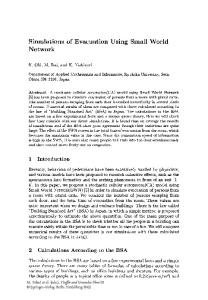EVACUATION NETWORKS
- PDF / 6,075,975 Bytes
- 64 Pages / 594 x 828 pts Page_size
- 51 Downloads / 382 Views
ORDI-
Selfadjoint eigenvalue problems for ordinary differential equations are very important in the sciences and in engineering. The characterization of eigenvalues by a minimum-maximum principle for the Rayleigh quotient forms the basis for the famous Rayleigh-Ritz method. This method allows for an efficient computation of nonincreasing upper eigenvalue bounds. N.J. Lehmann and H.J. Maehly [6], [7], [8] independently developed complementary characterizations that can be used to compute lower bounds. These methods are based on extremal principles for the Temple quotient. In general, however, an application of the LehmannMaehly method requires that certain quantities can be determined explicitly. This may be difficult or even impossible when dealing with partial differential equations. Of great importance is therefore a generalization, the Goerisch method [3], [4], [5], that may be used to overcome these problems. Nevertheless, the original Lehmann-Maehly method can easily be applied to a large class of ordinary differential equations; in [10] it is shown, that the method can be interpreted as a special application of the Rayleigh-Ritz method.
One can consider the right-definite eigenvalue problem Find
ACRand~EV,
s.t.
-
~#0,
( I )for all
(1) e V.
Problem (1) has a countable spectrum of eigenvalues, and the eigenvalues can be ordered by magnitude: 0 < ~1 _< /~2 _ 0, is a parameter. In order to treat this problem, the required quantities can be defined as follows: I := (0, ~/2), H "- L2(I),
V "- Hi(I).
The inner products (., .) and [., .] are given by 7r/2
(6)
E C V uEE dim E--i u=/=O
,
-0,
• '(0)-
the following ai therefore are characterized by ai =
• e
(/,
g) •- / f ( x )
g(x)dx
for a l l f , g E H ,
L ]
0
[/,g] - 9 p[ lu] + p2(
,
i - 1 , . . . , N. A negative upper bound for ai results in a lower bound for AN+I-i. In order to discretize (6), one determines w l , . . . , wn C H such that [ui]v] = (wi]v)
for ally e V,
(7)
then one defines the matrix A2
"-((Wi[Wk))i,k-1,...,n,
(8)
and solves the matrix eigenvalue problem (A1 - p A o ) x - T (A2 - 2 p A l + p2Ao) x,
(9)
(r, x) ~ R x R ~.
If for n E N the condition A~ ] < p is fulfilled, then (9) has exactly N negative eigenvalues T1 0; this can be used to verify the left hand side inequality of (5), the right-hand side inequality can be examined by means of the Rayleigh-Ritz bounds. For N = 4 one obtains
A3 _ O} a n d the (relative) interior of Fp by F ° - {x E R n" A x b ; x > O}. An n-vector x is called an interior solution of Program EL if x E Fp°. With these definitions, we have the following verifiable result" LEMMA 1 If Fp is nonempty, then Program EL has a unique optimal solution. Moreover, if Fp has a nonempty interior, then the unique optimal solution is strictly positive. K]
i=1
j--1
i=1
Considering the fact that dj > 0 and the shape of the entropic function x ln x, we know that, for any given y E R m and z E R~, L(x, y, z) achieves its unique minimum at x* > O. Also, its first derivative at x* vanishes. This implies m
Data Loading...











